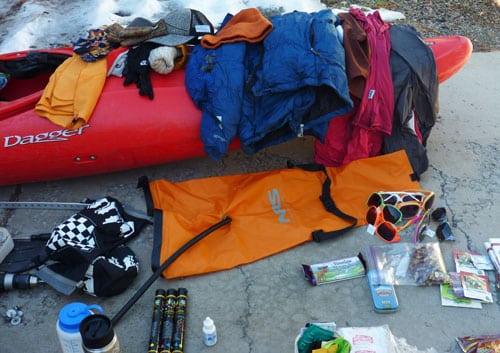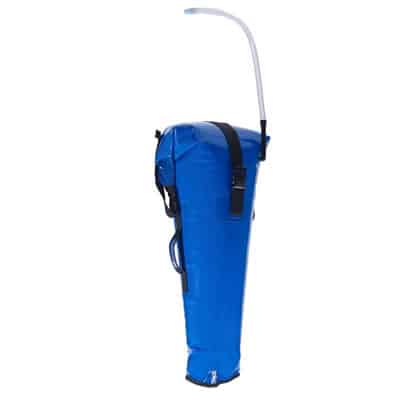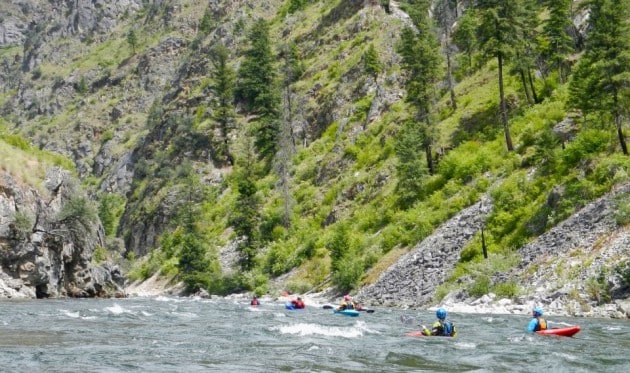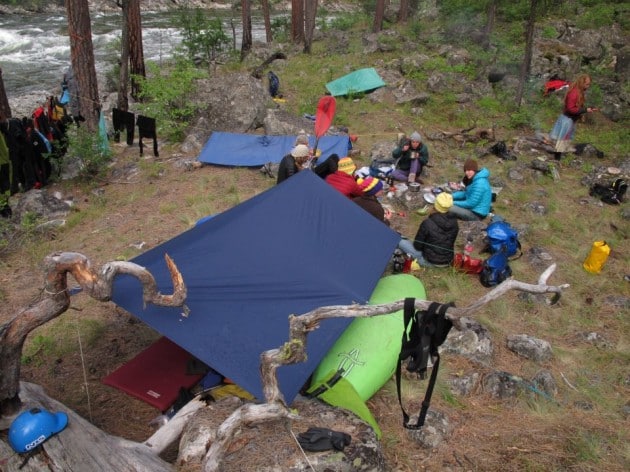Packing for a multi-day self support trip can be daunting. What do I bring? How do I keep everything dry? How does everything fit in my boat? Â While packing for a self-support river trip is not rocket science, it can be daunting. Here’s a few tips and tricks to help you pack your kayak, and keep your gear dry while on a self support river trip.
Susan Hollingsworth’s Grand Canyon gear explosion
One of the first questions most people ask, “How do I keep things dry?
Drybags! Drybags, in general, are stuff sacks made of a waterproof material, and sealed via a zip-closure or roll-top closure. They come in all sorts of shapes and sizes (and colors!) to fit your boat. Not all drybags are created equal, and like every sport, there are cheap and expensive bags. Consider spending the extra penny to ensure you have a dry sleeping bag at the end of the day.
While everyone has their own system, I recommend Watershed Futa Stow-float drybags. They double as both a drybag, and an airbag, giving you both flotation and storage. My personal overnight setup includes two of these stern drybags- one per side-, and a smaller drybag that rests between my legs. I put my snacks, camera, and items that need to be easily accessed in the drybag between my legs, while I distribute the rest between the stern bags.
** Remember, NOT all items need to go in drybags. Tent poles, fuel canisters, avocados, and the like can find home in the nooks and crannies (or bulkhead) of your boat, saving precious cargo space in your drybags**
How do I know what to bring?
Start with the necessary staples: a throw bag, a breakdown paddle, a pin-kit, a first aid kit, SPOT device, headlamp, leatherman, sleeping bag and pad, kitchen tools, food, and dry clothes.
-When packing clothes: Remember synthetic materials dry fast and provide more insulation than cotton. Â Cotton holds moisture to your skin, and can cause hypothermia even on the warmest of days. Consider a rain jacket/pants, and a puffy coat (a must in my opinion!).
-If you are paddling in the wilderness: Carry a Satellite phone or a SPOT device. Having some way to communicate in the event of an emergency is ESSENTIAL.
-Never skimp on food! It’s better to pack too much food than not enough! Have fun, and be creative with your meals: Pad Thai, Mediterranean Pitas, chicken skewers, etc. Dehydrated foods are a great option, but don’t be afraid to bring real food on the river!
-It never hurts to bring a tarp. In the event of a fluke rainstorm, you’ll have shelter. Not to mention, tarps are lighter than tents, and can easily be crammed into the bow of your boat.
Ladies in loaded boats on the SF Salmon River, Idaho
How do I best pack a drybag?
Most people find it easiest to place the empty drybag in the stern of their kayak before they load it.  Load light items, such as a puffy jacket and sleeping bag near the stern, and save the heavy items such as your stove/fuel canister and clothes for last. This will keep the weight at the center of your kayak, allowing for easier maneuverability through rapids, as well as prevents your boat from being too stern heavy.
Consider putting valuables/breakables, as well as snacks in a drybag that can go between your legs. It’s easy access, and keeps you from having to tear apart your kayak just to get to lunch.
Lastly, if you can, place canned foods, and the extras up in your bow. This will help you track straight and help when punching holes.
**Always, always, carabiner, or strap your drybags into your boat. In the event of a swim, at least your gear won’t go floating away.**
————————————————————————————————–
For more information, check out Erik Boomer, self-support extraordinaire, and his video on how to pack a kayak:Â http://www.canoekayak.com/skills/virtual-coach-how-to-self-support/
Happy Paddling!




